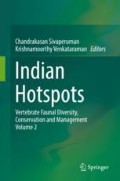Abstract
Biodiversity is integral to the direct benefits that humans receive from nature besides ecosystem services. However, human activities and the negative consequences of climate change are accelerating the loss of biodiversity. There are multiple indications of continuing decline in biodiversity in all three of its components – ecosystems, species and genes. In order to receive continuous ecosystem services and protect the species from extinction, 35 global biodiversity hotspots have been identified for conservation. It is nothing but a biogeographic region with significant levels of biodiversity that is threatened with destruction. The tropical island of Andaman and Nicobar is part of the global biodiversity hotspot having a large number of flora and fauna besides exhibiting great endemism. The recent assessment showed that the plant diversity of these islands comprises 3219 species under 1251 genera belonging to angiosperms, gymnosperms, pteridophytes, bryophytes, lichens and algae. Similarly 1463 species of fishes, 600 species of corals, 120 species of sponges, 290 species of butterflies, 300 species of birds and 36 species of mangroves were recorded. They are imperative for the livelihood of local people, a treasure for humankind; therefore, efforts should be made to strengthen the conservation efforts and preservation of threatened floral and faunal diversity of these islands.
Access this chapter
Tax calculation will be finalised at checkout
Purchases are for personal use only
References
Andrews HV (2001) Threatened herpetofauna of the Andaman and Nicobar Islands. In: Bambaradeniya CN, Samarasekara VN (eds) An overview of the threatened herpetofauna of South Asia. IUCN Sri Lanka and Asia Regional Biodiversity Programme, Colombo, pp 39–47
Anon (2015) Forest statistics. Department of Environment and Forest, Andaman and Nicobar Islands, p 125
Champion HG, Seth SK (1968) The revised forest types of India. CSIR, New Delhi
Conservation International: www.conservation.org
Das I (1999) Note worthy collection of mammals from Mount Harriet, Andaman Island, India. J South Asian Nat Hist 4(2):181–185
Dixit RD, Sinha BK (2001) Pteridophytes of Andaman and Nicobar Islands. Bishen Singh Mahendra Pal Singh, Dehra Dun
Ellis JL, Yoganarasimhan SN, Gurudeva MR, Ramanujam P (2000) Prioritization of biodiversity rich sites of conservation significance in the Andaman and Nicobar Islands. In: Singh S, Sastry ARK, Mehta R, Uppal V (eds) Setting biodiversity conservation priorities for India. WWF-India, New Delhi, pp 75–79
Gupta S, Porwal MC, Roy PS (2004) Orchid diversity of Great Nicobar biosphere reserve. Curr Sci 86(10):1372–1374
http://www.bsienvis.nic.in/Database/BiodiversityHotspotsinIndia_20500.aspx
IUCN (2001) IUCN red list categories and criteria: version 3.1. IUCN Species Survival Commission. IUCN, Gland/Cambridge, UK
Jagtap TG (1992) Marine flora of Nicobar group of islands in Andaman Sea. Indian J Mar Sci 21:56–58
Khatri TC (1993) Butterflies of the Andaman and Nicobar Islands: conservation concerns. J Res Lepidoptera 32:170–184
Kurz S (1870) Report on the vegetation of the Andaman Islands. Office of the Superintend of Government Printing, Calcutta
Lal J (2005) A check-list of Indian mosses. Bishen Singh Mahendra Pal Singh, Dehra Dun
Mcneely JA, Mittermeier RA, Brooks TM, Boltz F, Ash N (2009) The wealth of nature. CEMEX, Arlington
Millennium Ecosystem Assessment (2005) Ecosystems and human well-being: biodiversity synthesis. Island Press, Washington, DC
Mittermeier RA, Myers N, Gil PR, Mittermeier CG (1999) Hotspots: Earth’s biologically richest and most endangered terrestrial ecoregions. Cemex, Conservation International and Agrupacion Sierra Madre, Monterrey
Murugan C, Kamble MY (2012) A species of Tylophora from Andaman and Nicobar Islands. Rheedea 22(2):83–87
Myers N, Mittermeier RA, Mittermeier CG, da Fonseca GAB, Kent J (2000) Biodiversity hotspots for conservation priorities. Nature 403:853–858
Pandey RP, Diwakar PG (2008) An integrated check list of flora of Andaman and Nicobar Islands, India. J Econ Taxon Bot 32(2):403–500
Raghunathan C (2015) Littoral faunal diversity of Great Nicobar island. Rec zool Surv India, Occasional Paper No., 369: 1–172 (Published by the Director, Zool. Surv. India, Kolkata)
Rasmussen PC, Anderton JC (2012) Birds of South Asia: the Ripley guide, vol 1 & 2. Smithsonian Institution and Lynx Editions. Washington, DC/Barcelona, pp 1–378, 1–683
Singh LJ, Murugan C, Singh P (2014) Plant genetic diversity of endemic species in the Andaman and Nicobar Islands: a conservation perspective. In: Kumar P (ed) Island biodiversity. Uttar Pradesh State Biodiversity Board, Lucknow, pp 49–57
Sivaperuman C, Raghunathan C (2012) Fauna of the protected areas of Andaman and Nicobar Islands. Published by the Director, ZSI, Kolkata, pp 1–26
Stattersfield AJ, Crosby MJ, Long A, Wege DC (1998) Endemic bird area of the world. Priorities for biodiversity conservation. Bird Life International, Cambridge
Author information
Authors and Affiliations
Editor information
Editors and Affiliations
Rights and permissions
Copyright information
© 2018 Springer Nature Singapore Pte Ltd.
About this chapter
Cite this chapter
Jaisankar, I., Velmurugan, A., Swarnam, T.P., Singh, A.K. (2018). Hotspots: An Introduction and Role in Conservation. In: Sivaperuman, C., Venkataraman, K. (eds) Indian Hotspots. Springer, Singapore. https://doi.org/10.1007/978-981-10-6983-3_1
Download citation
DOI: https://doi.org/10.1007/978-981-10-6983-3_1
Published:
Publisher Name: Springer, Singapore
Print ISBN: 978-981-10-6982-6
Online ISBN: 978-981-10-6983-3
eBook Packages: Biomedical and Life SciencesBiomedical and Life Sciences (R0)

